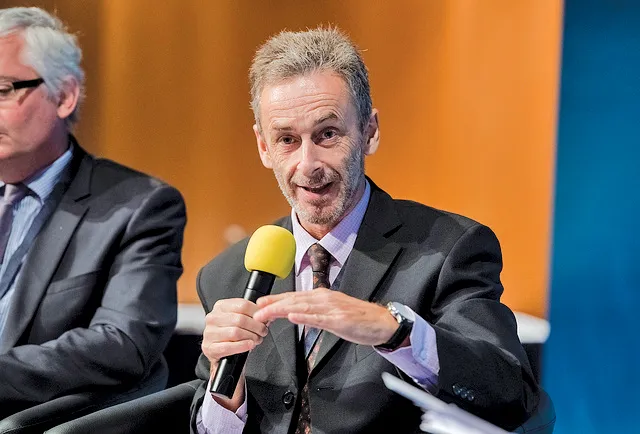The European Union Road Federation (ERF) has today launched a Position Paper that makes the case for a more widespread use of road markings on Europe’s roads as a means of increasing road safety and reducing the socio-economic impact of accidents.
Entitled ‘Marking the way towards a safer future’, the ERF is calling on EU Member States to establish intervention and maintenance policies to guarantee that road markings on Europe’s road remain visible for road users and, at same time, optimise the interaction
December 13, 2013
Read time: 3 mins
The 2866 European Union Road Federation (ERF) has today launched a Position Paper that makes the case for a more widespread use of road markings on Europe’s roads as a means of increasing road safety and reducing the socio-economic impact of accidents.
Entitled ‘Marking the way towards a safer future’, the ERF is calling on EU Member States to establish intervention and maintenance policies to guarantee that road markings on Europe’s road remain visible for road users and, at same time, optimise the interaction between the road infrastructure and the intelligent car.
The ERF states that road markings are one of the most cost-effective safety solutions available to policymakers and road owners. The influential federation adds that quality road markings provide drivers with much needed guidance, while also ensuring better hazard preview time and, at times, significantly help to avert the risks of run-off accidents and head-collisions. Nevertheless, as a result of budget cuts implemented by governments across Europe in recent years, the ERF says the quality of road markings across Europe have deteriorated significantly, and, in some cases, they have even disappeared altogether.
“The systematic under-maintenance of roads and road markings in particular represents first and foremost a hazard for the road user,” said George Lee, chairman of the ERF Working Group on Road Markings. “There is a plenty of empirical evidence and research findings that proves that road markings greatly increase driver comfort and can produce spectacular first year rates of return for road authorities and which are outlined in the report.”
In addition, and as outlined by1200 EuroRAP and EuroNCAP in their consultation paper launched in November 2013, the ERF stats that the absence of visible road markings also essentially negates the large potential safety benefits that can arise from the introduction of Lane Departure Warning Systems in new vehicles.
The ERF’s solution is to establish intervention and maintenances standards that can ensure markings remains visible at all time, both to the driver and the intelligent vehicle irrespective of light conditions (day vs night), weather conditions (dry vs wet vs wet and rainy) and age (young vs old).
“We believe that this can be summarised by the simple 150x150. In other words, road markings should have a minimum performance 150mcd/lux/m² and a minimum width of 150 mm for all roads. For wet and rainy conditions, the minimum performance level should be 35mcd/lux/m² (RW2),” added Lee.
“We know that this is feasible from a technological point of view and believe that any additional costs will be more than compensated by better increased safety levels and reduction in accidents. This is why, after all, our proposal has been endorsed by a wider range of stakeholders. Thus, what we are calling for in practice is for Member States to honour their pledge made at Leipzig Summit and allocate to road administrations sufficient funds to keep Europe’s roads safe.”
Entitled ‘Marking the way towards a safer future’, the ERF is calling on EU Member States to establish intervention and maintenance policies to guarantee that road markings on Europe’s road remain visible for road users and, at same time, optimise the interaction between the road infrastructure and the intelligent car.
The ERF states that road markings are one of the most cost-effective safety solutions available to policymakers and road owners. The influential federation adds that quality road markings provide drivers with much needed guidance, while also ensuring better hazard preview time and, at times, significantly help to avert the risks of run-off accidents and head-collisions. Nevertheless, as a result of budget cuts implemented by governments across Europe in recent years, the ERF says the quality of road markings across Europe have deteriorated significantly, and, in some cases, they have even disappeared altogether.
“The systematic under-maintenance of roads and road markings in particular represents first and foremost a hazard for the road user,” said George Lee, chairman of the ERF Working Group on Road Markings. “There is a plenty of empirical evidence and research findings that proves that road markings greatly increase driver comfort and can produce spectacular first year rates of return for road authorities and which are outlined in the report.”
In addition, and as outlined by
The ERF’s solution is to establish intervention and maintenances standards that can ensure markings remains visible at all time, both to the driver and the intelligent vehicle irrespective of light conditions (day vs night), weather conditions (dry vs wet vs wet and rainy) and age (young vs old).
“We believe that this can be summarised by the simple 150x150. In other words, road markings should have a minimum performance 150mcd/lux/m² and a minimum width of 150 mm for all roads. For wet and rainy conditions, the minimum performance level should be 35mcd/lux/m² (RW2),” added Lee.
“We know that this is feasible from a technological point of view and believe that any additional costs will be more than compensated by better increased safety levels and reduction in accidents. This is why, after all, our proposal has been endorsed by a wider range of stakeholders. Thus, what we are calling for in practice is for Member States to honour their pledge made at Leipzig Summit and allocate to road administrations sufficient funds to keep Europe’s roads safe.”







